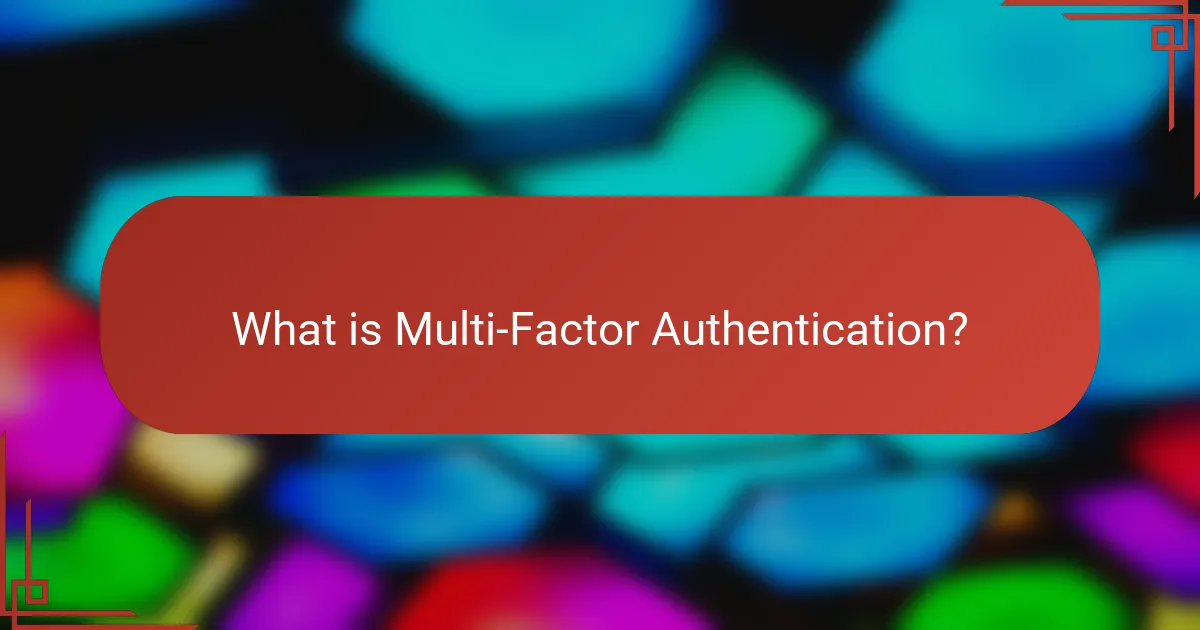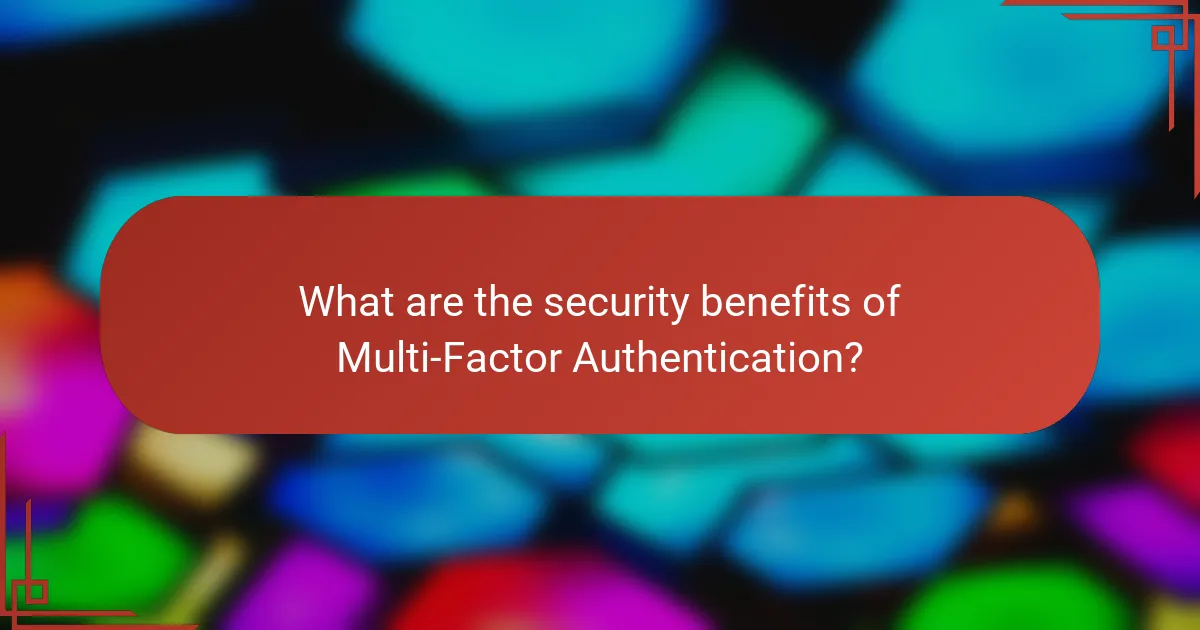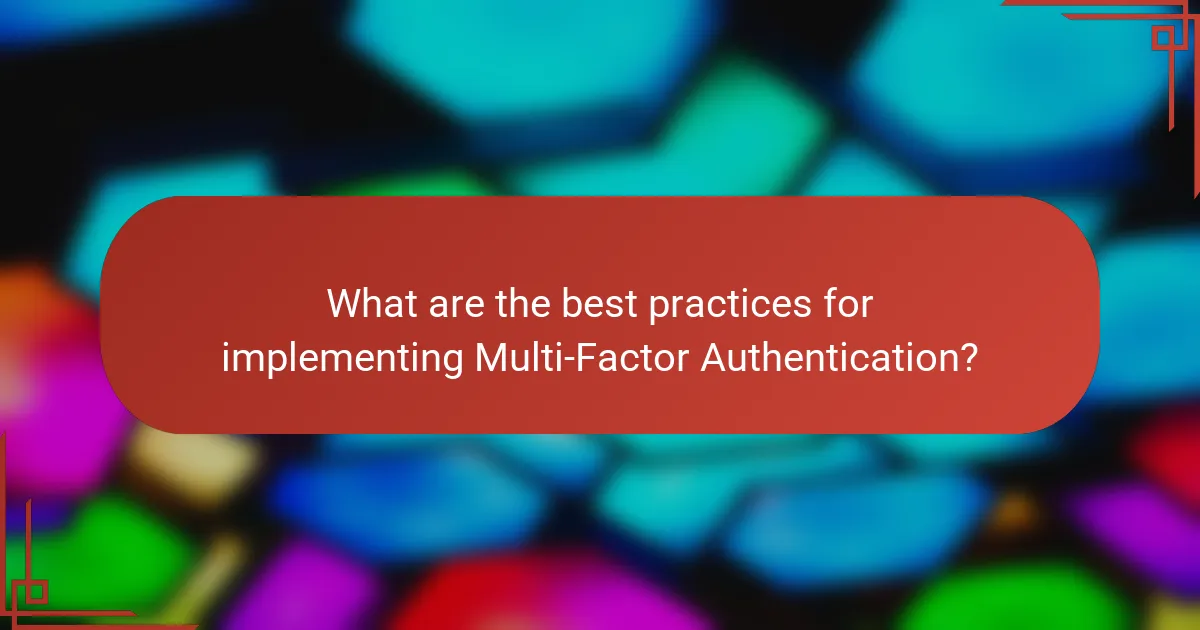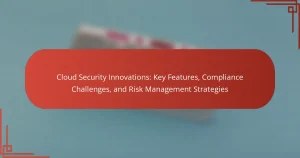Multi-Factor Authentication (MFA) is a critical security mechanism that enhances account protection by requiring multiple forms of verification, such as a password combined with a mobile device. This approach significantly lowers the risk of unauthorized access and can block over 99% of automated cyberattacks, according to the Cybersecurity & Infrastructure Security Agency. The article outlines the benefits of MFA, including its role in safeguarding sensitive information and reducing identity theft. Additionally, it provides best practices for implementing MFA effectively, such as selecting reliable methods, ensuring user enrollment, and maintaining regular security reviews. By following these guidelines, organizations can strengthen their cybersecurity posture and minimize security incidents.

What is Multi-Factor Authentication?
Multi-Factor Authentication (MFA) is a security mechanism that requires multiple forms of verification to access an account. This method enhances security by combining something the user knows, like a password, with something the user has, such as a mobile device. MFA significantly reduces the risk of unauthorized access. According to the Cybersecurity & Infrastructure Security Agency, MFA can block over 99% of automated attacks. This statistic underscores its effectiveness in protecting sensitive information. MFA is widely adopted across various platforms, including banking and email services. Its implementation is considered a best practice in cybersecurity.
How does Multi-Factor Authentication enhance security?
Multi-Factor Authentication (MFA) enhances security by requiring multiple forms of verification before granting access. This process typically involves something the user knows, something the user has, or something the user is. By combining these factors, MFA significantly reduces the risk of unauthorized access. According to a study by Microsoft, MFA can block over 99.9% of account compromise attacks. This statistic underscores the effectiveness of MFA in protecting sensitive information. Additionally, MFA addresses vulnerabilities associated with password-only systems, which are often susceptible to breaches. By implementing MFA, organizations can create a more robust security framework.
What are the different factors used in Multi-Factor Authentication?
The different factors used in Multi-Factor Authentication (MFA) include something you know, something you have, and something you are. “Something you know” refers to knowledge-based factors like passwords or PINs. “Something you have” involves possession-based factors such as security tokens or mobile devices. “Something you are” pertains to biometric factors like fingerprints or [censured] recognition. Each factor adds an additional layer of security, making unauthorized access significantly more difficult. According to the National Institute of Standards and Technology (NIST), using multiple factors reduces the risk of security breaches.
How do these factors work together to improve security?
Multi-factor authentication (MFA) improves security by requiring multiple forms of verification. This process combines something the user knows, like a password, with something the user has, such as a mobile device. By implementing these factors together, the likelihood of unauthorized access decreases significantly. According to a study by Microsoft, MFA can block over 99.9% of automated attacks. Each additional factor adds a layer of protection, making it harder for attackers to gain access. Thus, the integration of various verification methods reinforces overall security.
Why is Multi-Factor Authentication important for organizations?
Multi-Factor Authentication (MFA) is important for organizations because it significantly enhances security. MFA requires users to provide two or more verification factors to gain access. This reduces the risk of unauthorized access, even if passwords are compromised. According to a study by the Ponemon Institute, organizations using MFA can reduce the risk of data breaches by 99.9%. This is crucial as cyber threats continue to evolve. Implementing MFA protects sensitive information and maintains customer trust. Overall, MFA is a vital component of a robust cybersecurity strategy for organizations.
What are the potential risks of not implementing Multi-Factor Authentication?
The potential risks of not implementing Multi-Factor Authentication (MFA) include increased vulnerability to unauthorized access. Without MFA, a single compromised password can grant full access to sensitive accounts. This significantly raises the likelihood of data breaches. According to a report by Verizon, 81% of data breaches are linked to stolen or weak passwords. Additionally, organizations may face financial losses and reputational damage due to security incidents. The absence of MFA also makes it easier for attackers to execute phishing and social engineering attacks. In summary, not implementing MFA exposes individuals and organizations to serious security threats and potential financial repercussions.
How does Multi-Factor Authentication protect sensitive data?
Multi-Factor Authentication (MFA) protects sensitive data by requiring multiple forms of verification before granting access. This process adds layers of security beyond just a password. Common factors include something the user knows (like a password), something the user has (like a smartphone), and something the user is (like a fingerprint).
By combining these factors, MFA significantly reduces the risk of unauthorized access. For example, even if a password is compromised, a hacker would still need the second factor to gain access. According to a 2019 report by the Cybersecurity & Infrastructure Security Agency, MFA can block 99.9% of automated attacks. This demonstrates its effectiveness in safeguarding sensitive information.

What are the security benefits of Multi-Factor Authentication?
Multi-Factor Authentication (MFA) significantly enhances security by requiring multiple forms of verification to access accounts. This process reduces the likelihood of unauthorized access. MFA typically combines something the user knows, like a password, with something the user has, such as a mobile device. According to a study by the Cybersecurity & Infrastructure Security Agency, MFA can block over 99% of automated cyberattacks. By adding layers of security, MFA protects sensitive information even if a password is compromised. Implementing MFA is a proactive measure against identity theft and data breaches. Organizations that use MFA experience fewer security incidents, reinforcing its effectiveness as a security measure.
How does Multi-Factor Authentication prevent unauthorized access?
Multi-Factor Authentication (MFA) prevents unauthorized access by requiring multiple forms of verification before granting access. This process typically involves something the user knows, such as a password, and something the user has, like a smartphone for a verification code. By combining these factors, MFA significantly increases security.
Studies show that MFA can block up to 99.9% of automated attacks. For instance, a 2020 report by Microsoft highlighted that MFA could prevent 90% of account compromise incidents. This layered defense approach makes it more difficult for attackers to gain access, even if they have one credential.
What role does user verification play in security benefits?
User verification enhances security by ensuring that individuals accessing systems are who they claim to be. This process reduces the risk of unauthorized access and data breaches. Multi-factor authentication (MFA) is a key method of user verification. MFA requires users to provide two or more verification factors. These factors can include something they know, something they have, or something they are. According to a report by Microsoft, MFA can block 99.9% of account compromise attacks. Thus, user verification through MFA significantly bolsters security measures, protecting sensitive information from potential threats.
How does Multi-Factor Authentication reduce the risk of phishing attacks?
Multi-Factor Authentication (MFA) reduces the risk of phishing attacks by requiring multiple forms of verification to access accounts. This adds an extra layer of security beyond just a password. Even if a user’s password is compromised, the attacker would still need the second factor to gain access. Common second factors include SMS codes, authenticator apps, or biometric verification. According to the Cybersecurity & Infrastructure Security Agency, MFA can block 99.9% of automated cyber attacks. This statistic highlights the effectiveness of MFA in preventing unauthorized access through phishing.
What impact does Multi-Factor Authentication have on compliance?
Multi-Factor Authentication (MFA) enhances compliance with security regulations. It reduces the risk of unauthorized access to sensitive data. Organizations implementing MFA align with standards like GDPR and HIPAA. These regulations require strong authentication measures to protect personal information. MFA adds an extra layer of security beyond just passwords. This proves beneficial in audits and assessments for compliance. Studies show that organizations using MFA experience fewer data breaches. This further supports compliance by maintaining data integrity and confidentiality.
Which regulations require the use of Multi-Factor Authentication?
Regulations that require the use of Multi-Factor Authentication (MFA) include the General Data Protection Regulation (GDPR) and the Health Insurance Portability and Accountability Act (HIPAA). GDPR mandates strong security measures for personal data protection. MFA is a critical component of these measures. HIPAA requires covered entities to implement security safeguards for electronic protected health information. MFA helps ensure the confidentiality and integrity of this sensitive data. Additionally, the Payment Card Industry Data Security Standard (PCI DSS) also requires MFA for accessing cardholder data. These regulations highlight the necessity of MFA in protecting sensitive information across various industries.
How can Multi-Factor Authentication help in meeting compliance standards?
Multi-Factor Authentication (MFA) helps meet compliance standards by adding an extra layer of security. It requires users to provide two or more verification factors to gain access. This process enhances identity verification and reduces the risk of unauthorized access. Many regulations, such as GDPR and HIPAA, mandate strong access controls. Implementing MFA can demonstrate a commitment to data protection and risk management. Organizations that use MFA can better safeguard sensitive information. This practice can lead to fewer data breaches and compliance violations. Consequently, it supports adherence to industry-specific regulations and standards.

What are the best practices for implementing Multi-Factor Authentication?
Implementing Multi-Factor Authentication (MFA) requires adherence to specific best practices. First, choose a reliable MFA method such as SMS, email, or authenticator apps. Each method provides an additional security layer beyond the password. Second, ensure that all users are enrolled in MFA. This includes employees, contractors, and any third-party vendors with access. Third, provide user training on the importance and use of MFA. Educating users helps minimize resistance and enhances security awareness.
Fourth, regularly review and update MFA settings. This ensures that the methods used remain secure against evolving threats. Fifth, implement backup options for MFA. Users should have alternative methods to access their accounts if their primary method fails. Lastly, monitor and log MFA attempts. This practice helps identify and respond to suspicious activities promptly. Following these best practices significantly enhances the security posture of any organization.
How should organizations choose the right Multi-Factor Authentication methods?
Organizations should choose Multi-Factor Authentication (MFA) methods based on their specific security needs and user convenience. They must assess the sensitivity of the data being protected. Higher sensitivity data requires stronger authentication methods. Organizations should evaluate available MFA options, such as SMS, email, or authenticator apps. Each option has different security levels and user experiences.
Cost-effectiveness is also a crucial factor. Some methods may incur higher costs due to implementation and maintenance. User adoption rates impact the effectiveness of chosen methods. Organizations should prioritize methods that are easy for users to adopt without compromising security.
Compliance with industry regulations is essential. Organizations must ensure their MFA methods meet legal and regulatory requirements. Regularly reviewing and updating MFA strategies is necessary to adapt to evolving security threats. This approach ensures that organizations maintain strong protection against unauthorized access.
What factors should be considered when selecting authentication methods?
When selecting authentication methods, several key factors must be considered. Security strength is paramount. Stronger methods reduce the risk of unauthorized access. Usability is also critical. Users should find the method easy to use. Compatibility with existing systems is essential. The chosen method must integrate seamlessly with current technology. Cost-effectiveness should not be overlooked. Organizations need to evaluate the financial implications of implementing a method. Regulatory compliance is another factor. Authentication methods must meet industry standards and legal requirements. Lastly, scalability is important. The method should accommodate future growth and changes in user numbers. These considerations ensure that the selected authentication method is both effective and sustainable.
How can the user experience be improved during implementation?
User experience can be improved during implementation by simplifying the multi-factor authentication (MFA) process. Streamlining the steps required to complete MFA enhances user satisfaction. Providing clear instructions and visual aids can reduce confusion. Additionally, offering multiple authentication methods caters to different user preferences. For example, users may prefer SMS codes, authenticator apps, or biometric options. Implementing a feedback mechanism allows users to report issues and suggest improvements. According to a study by the National Institute of Standards and Technology, user-friendly MFA systems significantly increase compliance rates. This indicates that improving user experience directly correlates with higher security adherence.
What common challenges arise during Multi-Factor Authentication implementation?
Common challenges during Multi-Factor Authentication (MFA) implementation include user resistance, integration complexity, and cost concerns. User resistance often stems from perceived inconvenience. Many users are accustomed to single-factor authentication and may find MFA cumbersome. Integration complexity arises when MFA solutions must work with existing systems and applications. This can lead to technical difficulties and increased workload for IT teams. Cost concerns may arise from the need for additional hardware or software. Organizations must budget for ongoing maintenance and support as well. Additionally, training users on new processes can be time-consuming and may lead to temporary productivity losses. These challenges can hinder the successful adoption of MFA solutions.
How can organizations overcome resistance to Multi-Factor Authentication?
Organizations can overcome resistance to Multi-Factor Authentication (MFA) by implementing comprehensive education and communication strategies. Educating employees about the security benefits of MFA enhances understanding and acceptance. Providing clear information on how MFA protects sensitive data can alleviate concerns. Organizations should also address usability issues by selecting user-friendly authentication methods. Offering training sessions can help users feel more comfortable with new processes. Involving employees in the implementation process fosters a sense of ownership. Additionally, showcasing real-world examples of MFA preventing data breaches can reinforce its importance. Research indicates that organizations that actively engage employees in security practices see higher compliance rates.
What strategies can be employed to educate users about Multi-Factor Authentication?
Employing interactive training sessions is an effective strategy to educate users about Multi-Factor Authentication (MFA). These sessions can provide hands-on experience with MFA processes. Users can learn how to set up MFA on their accounts. Simulations can demonstrate how MFA protects against unauthorized access.
Providing clear, concise documentation is also essential. Users benefit from step-by-step guides on enabling MFA. Visual aids, such as infographics, can enhance understanding. Regular email reminders about MFA importance can keep users informed.
Utilizing real-life examples of security breaches can illustrate the necessity of MFA. Case studies show how MFA prevents unauthorized access effectively. Gamification of the learning process can increase engagement. Quizzes and rewards can motivate users to complete training.
Incorporating these strategies can significantly enhance user awareness and compliance with MFA protocols.
What are practical tips for successful Multi-Factor Authentication deployment?
Implementing Multi-Factor Authentication (MFA) successfully requires strategic planning. First, assess the specific security needs of your organization. Identify critical systems and data that require enhanced protection. Next, choose appropriate authentication methods that balance security and user convenience. Common methods include SMS codes, authentication apps, or hardware tokens.
Educate users on the importance of MFA to ensure compliance. Provide clear instructions on how to set up and use MFA. Regularly review and update your MFA policies to adapt to emerging threats. Monitor the effectiveness of your MFA implementation through audits and user feedback.
According to a report by Microsoft, MFA can block 99.9% of automated attacks. This statistic underscores the effectiveness of MFA in enhancing security.
Multi-Factor Authentication (MFA) is a critical security mechanism that enhances account protection by requiring multiple forms of verification, such as passwords and mobile devices. This article outlines the significant security benefits of MFA, including its ability to block over 99% of automated attacks and reduce the risk of data breaches. It details the various factors used in MFA, the importance of user verification, and the impact of MFA on compliance with regulations like GDPR and HIPAA. Additionally, best practices for implementing MFA, common challenges faced, and strategies to educate users are discussed to ensure successful deployment and increased security awareness.


